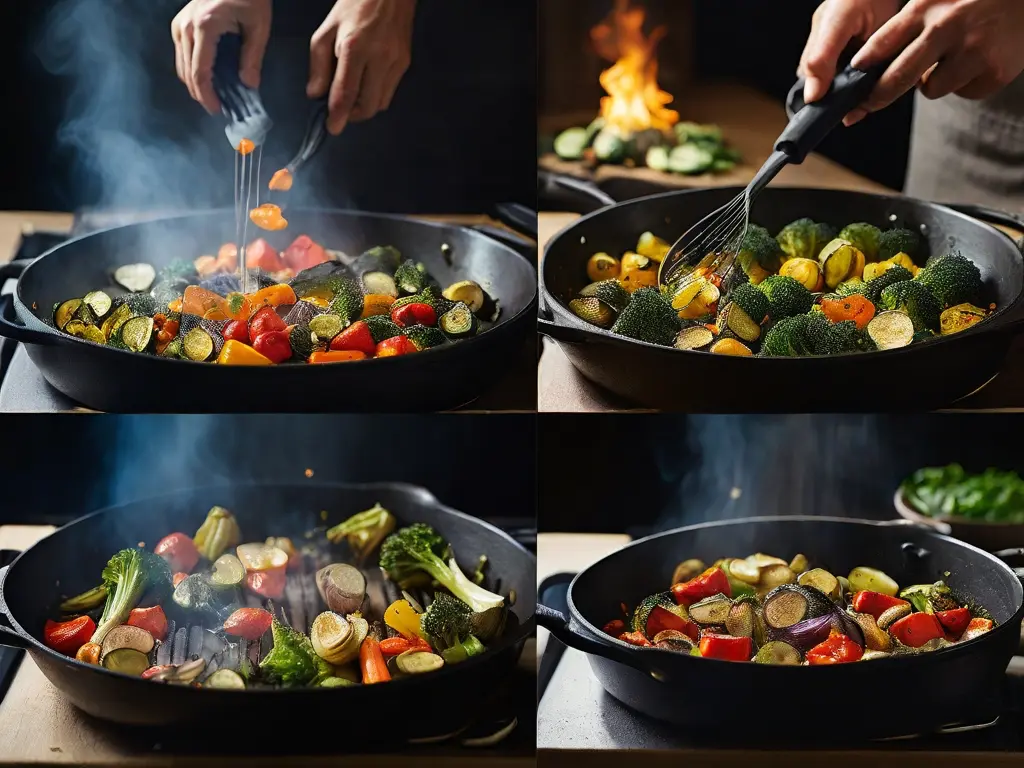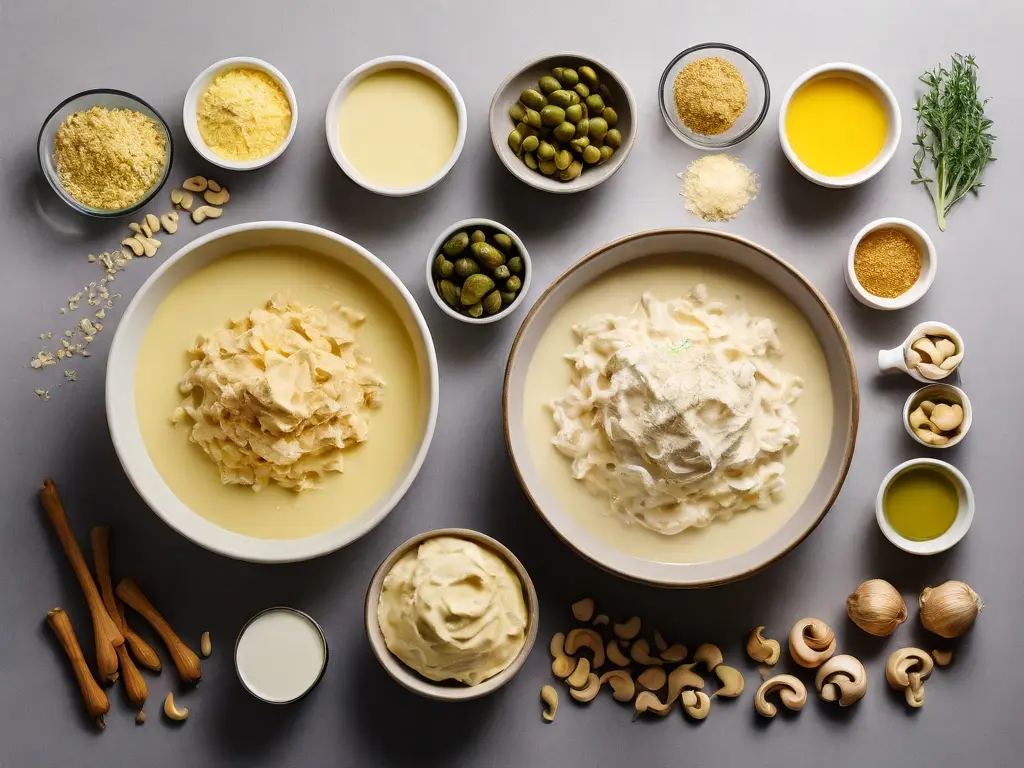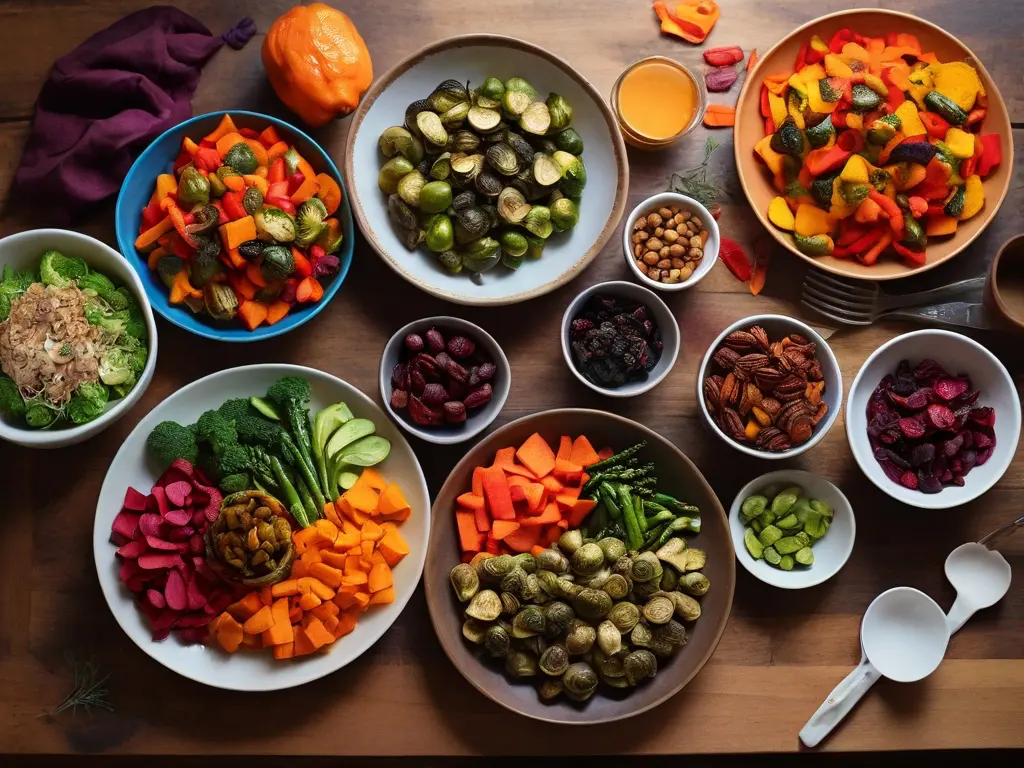Table of Contents
Introduction
Veganism has evolved from a niche dietary choice to a mainstream lifestyle embraced by millions worldwide. At its core, veganism excludes all animal products, including meat, dairy, eggs, and honey, focusing instead on plant-based alternatives. When it comes to creating satisfying vegan meals, vegetable side dishes play a crucial role, not just as accompaniments but often as stars of the dining experience.
Vegan vegetable side dishes offer incredible versatility, vibrant flavors, and nutritional benefits that can transform any meal. Whether you’re a committed vegan, experimenting with plant-based eating, or simply looking to incorporate more vegetables into your diet, mastering the art of vegan vegetable sides will elevate your culinary repertoire and bring new dimensions to your dining table.
In this comprehensive guide, we’ll explore everything you need to know about creating spectacular vegan vegetable side dishes that will delight even the most dedicated omnivores. From essential ingredients and cooking techniques to seasonal recommendations and creative substitutions, you’ll discover how to make vegetables the highlight of any meal.
Benefits of Vegan Vegetable Side Dishes
Incorporating more vegan vegetable side dishes into your meal planning offers numerous health advantages while supporting environmental sustainability.
Nutritional Powerhouses
Vegan vegetable side dishes provide an abundance of essential nutrients:
| Nutrient | Benefits | Common Sources |
|---|---|---|
| Fiber | Supports digestive health, helps manage weight, and promotes satiety | Brussels sprouts, broccoli, carrots |
| Vitamins | Boosts immune function and supports cellular health | Bell peppers (vitamin C), sweet potatoes (vitamin A), leafy greens (vitamin K) |
| Minerals | Maintains bone health, nerve function, and energy production | Spinach (iron), mushrooms (selenium), asparagus (folate) |
| Antioxidants | Fights inflammation and protects against chronic diseases | Purple cabbage, kale, tomatoes |
| Phytonutrients | Supports overall health and may reduce disease risk | Colorful vegetables like beetroot, squash, and eggplant |
“Eating a rainbow of vegetable side dishes isn’t just visually appealing—it’s one of the simplest ways to ensure you’re getting a diverse array of nutrients your body needs for optimal health.” — Nutrition experts
Environmental Impact
Choosing plant-based side dishes contributes to:
- Reduced carbon footprint
- Lower water usage compared to animal-based foods
- Decreased land use for food production
- Less overall environmental pollution
Culinary Advantages
Beyond health and environmental benefits, vegan vegetable side dishes offer:
- Greater menu versatility
- Vibrant colors and presentation
- Diverse textures and flavors
- Opportunity for cultural culinary exploration
- Budget-friendly meal components
Ingredients Guide for Perfect Vegan Vegetable Side Dishes
Creating delicious vegan vegetable sides starts with selecting the right ingredients. Here’s what you need to stock your plant-based pantry:
Essential Vegetables
Root Vegetables:
- Potatoes (sweet, russet, red, fingerling)
- Carrots
- Parsnips
- Beets
- Turnips
- Radishes
Cruciferous Vegetables:
- Broccoli
- Cauliflower
- Brussels sprouts
- Cabbage
- Kale
Leafy Greens:
- Spinach
- Collard greens
- Swiss chard
- Arugula
- Bok choy
Other Versatile Vegetables:
- Zucchini and summer squash
- Bell peppers
- Eggplant
- Mushrooms (portobello, shiitake, cremini)
- Corn
- Green beans
- Asparagus
- Artichokes
Vegan-Friendly Oils & Fats
- Olive oil – Perfect for Mediterranean-inspired dishes
- Coconut oil – Great for higher-heat cooking and Asian-inspired dishes
- Avocado oil – Has a high smoke point, ideal for roasting
- Sesame oil – Adds distinctive flavor to East Asian dishes
- Nut oils (walnut, hazelnut) – Specialty oils for drizzling and finishing dishes
Herbs & Spices
Fresh Herbs:
- Basil
- Cilantro
- Parsley
- Mint
- Dill
- Rosemary
- Thyme
- Sage
Essential Spices:
- Garlic powder
- Onion powder
- Cumin
- Paprika (sweet, smoked, hot)
- Turmeric
- Coriander
- Red pepper flakes
- Black pepper
- Nutritional yeast (for cheesy flavor)
Vegan-Friendly Condiments & Flavor Boosters
- Tamari or soy sauce (check labels for fish ingredients)
- Miso paste
- Vegetable broth (verify it’s vegan; some contain chicken fat)
- Tahini
- Dijon mustard
- Maple syrup
- Agave nectar
- Apple cider vinegar
- Balsamic vinegar
- Rice vinegar
- Lemon and lime juice
- Vegan Worcestershire sauce (traditional contains anchovies)
Hidden Animal Products to Watch For
When shopping for ingredients, be vigilant about these common non-vegan additions:
- Vegetable broth – May contain chicken fat or beef extract
- Wine – Some varieties use animal-derived fining agents
- Sugar – Some refined sugars are processed with bone char
- Seasonings and spice blends – May contain milk powder or other animal derivatives
- Pre-made sauces – Often contain dairy, eggs, or fish ingredients
Always check labels or contact manufacturers if you’re unsure about an ingredient’s vegan status.
Cooking Techniques for Perfect Vegan Vegetables

The cooking method you choose can dramatically impact the flavor, texture, and nutritional content of your vegan vegetable side dishes. Here’s how to master each technique:
Roasting
Roasting caramelizes the natural sugars in vegetables, creating deep, complex flavors and delightfully crispy edges.
Best for: Root vegetables, Brussels sprouts, cauliflower, broccoli, bell peppers, and squash
Key tips:
- Preheat your oven to 400-425°F (200-220°C)
- Cut vegetables into uniform sizes for even cooking
- Toss with oil, salt, and desired seasonings
- Arrange in a single layer on a baking sheet
- Roast until edges are browned and centers are tender
Flavor boost: Add whole garlic cloves, herbs like rosemary or thyme, or a sprinkle of nutritional yeast in the last few minutes of cooking
Steaming
Steaming preserves nutrients and results in tender vegetables with bright colors and clean flavors.
Best for: Delicate greens, broccoli, cauliflower, carrots, and green beans
Key tips:
- Use a steamer basket or colander over boiling water
- Avoid overcrowding the steamer
- Steam until vegetables are just tender when pierced with a fork
- Season after cooking for the brightest flavors
Flavor boost: Add aromatics like lemon slices, garlic, or ginger to the steaming water
Sautéing
Quick and versatile, sautéing delivers vegetables with a satisfying texture—tender inside with slight caramelization outside.
Best for: Leafy greens, zucchini, bell peppers, mushrooms, and snap peas
Key tips:
- Heat pan before adding oil
- Don’t overcrowd the pan (cook in batches if needed)
- Stir frequently over medium-high heat
- Add hardy vegetables first, followed by more delicate ones
Flavor boost: Deglaze the pan with a splash of white wine, vegetable stock, or balsamic vinegar to capture all the delicious browned bits
Grilling
Perfect for summer cooking, grilling imparts smoky flavors and appealing char marks.
Best for: Corn, eggplant, bell peppers, zucchini, asparagus, and portobello mushrooms
Key tips:
- Preheat grill to medium-high
- Lightly oil vegetables to prevent sticking
- Use a grill basket for smaller pieces
- Watch closely to prevent burning
Flavor boost: Brush with herb-infused oil or a simple marinade before grilling
Air Frying
The air fryer creates crispy, delicious vegetables with minimal oil.
Best for: Potato wedges, Brussels sprouts, cauliflower, and chickpeas
Key tips:
- Preheat the air fryer
- Toss vegetables in a light coating of oil
- Arrange in a single layer, cooking in batches if necessary
- Shake basket halfway through cooking
Flavor boost: Toss with spice blends like curry powder, za’atar, or Cajun seasoning before cooking
Raw Preparations
No cooking required—just fresh, vibrant flavors and maximum nutrient retention.
Best for: Salads, slaws, and vegetable platters featuring cucumbers, tomatoes, carrots, and bell peppers
Key tips:
- Slice or chop uniformly for visual appeal
- Massage tougher greens like kale with a bit of oil and salt to tenderize
- Add an acid (lemon juice, vinegar) to brighten flavors
Flavor boost: Create a quick dressing with tahini, lemon juice, and herbs for drizzling
Seasonal Vegan Vegetable Side Dishes

Cooking with seasonal vegetables ensures the best flavor, nutritional value, and environmental sustainability. Here’s a guide to outstanding vegan vegetable side dishes by season:
Spring Vegan Vegetable Side Dishes
Spring brings tender new vegetables that shine with minimal preparation:
- Lemon-Garlic Asparagus – Quick-sautéed with lemon zest
- Minted Spring Pea Salad – Fresh peas with mint and a light lemon dressing
- Roasted Radishes with Herbs – Transforms the peppery bite into sweet tenderness
- Braised Baby Artichokes – Simmered with white wine and herbs
- Spring Greens with Strawberries – Tender lettuces with sweet berries and balsamic
Summer Vegan Vegetable Side Dishes
Summer’s abundant harvest offers endless possibilities:
- Grilled Corn with Herb Butter – Brushed with vegan herb butter
- Marinated Cucumber and Tomato Salad – Classic summer combination with red onion and herbs
- Sautéed Summer Squash Medley – Yellow squash and zucchini with fresh herbs
- Grilled Eggplant with Tahini Drizzle – Smoky eggplant with creamy tahini sauce
- Chilled Gazpacho Salad – Chunky deconstructed gazpacho as a refreshing side
Fall Vegan Vegetable Side Dishes
Fall vegetables benefit from warm spices and hearty cooking methods:
- Maple-Roasted Brussels Sprouts – Caramelized with a touch of maple syrup
- Rosemary Roasted Root Vegetables – A medley of carrots, parsnips, and sweet potatoes
- Balsamic Glazed Beets – Sweet, tangy, and earthy
- Curried Cauliflower – With warming spices and toasted cashews
- Wild Mushroom Sauté – Mixed mushrooms with thyme and garlic
Winter Vegan Vegetable Side Dishes
Winter calls for comfort and richness in vegetable preparation:
- Garlic Mashed Cauliflower – Creamy alternative to mashed potatoes
- Roasted Brussels Sprouts with Cranberries – Sweet-tart combination with a balsamic glaze
- Braised Red Cabbage – Slow-cooked with apples and warming spices
- Hasselback Butternut Squash – Sliced and roasted to perfection
- Kale and White Bean Sauté – Hearty and nutritious winter combination
Vegan Substitutions for Common Non-Vegan Ingredients

Many traditional vegetable side dishes rely on animal products for richness and flavor. Here’s how to veganize them without compromising on taste:
Dairy Alternatives
Instead of Butter:
- Olive oil or coconut oil
- Vegan butter (store-bought)
- Tahini (for creaminess)
- Nut butters (for richness)
Instead of Cream:
- Coconut milk or cream
- Cashew cream (blend soaked cashews with water)
- Silken tofu puree
- Plant-based milk thickened with cornstarch
Instead of Cheese:
- Nutritional yeast (for cheesy flavor)
- Homemade nut-based cheese sauce
- Store-bought vegan cheese
- Crumbled tofu with herbs (for feta-like texture)
Other Common Substitutions
Instead of Honey:
- Maple syrup
- Agave nectar
- Date syrup
- Apple or pear concentrate
Instead of Worcestershire Sauce:
- Soy sauce mixed with a touch of maple syrup and vinegar
- Store-bought vegan Worcestershire sauce
- Miso paste thinned with water
Instead of Beef/Chicken Stock:
- Vegetable stock
- Mushroom stock (for umami)
- Miso broth
- Kombu or dried mushroom broth
Instead of Egg (for binding):
- Flax egg (1 Tbsp ground flaxseed + 3 Tbsp water)
- Aquafaba (liquid from canned chickpeas)
- Cornstarch slurry
- Commercial egg replacer
Tips for Picky Eaters
Converting vegetable skeptics into enthusiasts requires some strategic approaches. These techniques can help win over even the most dedicated vegetable avoiders:
Texture Modifications
- Crispy Preparations – Many people who dislike vegetables actually object to soft textures. Try air-frying or roasting until crispy
- Hidden Vegetables – Incorporate finely diced or grated vegetables into sauces and dips
- Smooth Options – Blend vegetables into creamy soups or purees to eliminate texture concerns
- Veggie Fries – Cut vegetables like sweet potatoes, zucchini, or carrots into fry shapes and bake until crisp
Flavor Enhancement Strategies
- Smoky Elements – Add smoked paprika or liquid smoke for depth
- Umami Boosters – Incorporate nutritional yeast, miso, or tamari
- Sweet Additions – A touch of maple syrup or balsamic glaze can balance bitter vegetables
- Familiar Flavors – Use favorite spice blends or sauces as a bridge to new vegetables
Presentation Techniques
- Colorful Arrangements – Create visually appealing rainbow platters
- Dipping Options – Serve vegetables with delicious vegan dips
- Playful Shapes – Use cookie cutters for fun shapes
- Involvement – Let picky eaters help prepare the vegetables
“The best way to convert a vegetable skeptic is to meet them where they are. Start with familiar preparations and gradually introduce new vegetables in ways that align with their existing preferences.” — Veteran plant-based chef
Pairing Suggestions for Vegan Vegetable Side Dishes
The right vegetable side dish can elevate any main course. Here are perfect pairings for various plant-based entrées:
With Hearty Vegan Proteins
- Lentil loaf pairs well with garlic mashed cauliflower or roasted Brussels sprouts
- Seitan roast complements maple-glazed carrots or herb-roasted potatoes
- Chickpea cutlets match nicely with lemon-garlic green beans or braised kale
- Tofu steaks are enhanced by grilled asparagus or mushroom sauté
With Grain-Based Mains
- Risotto pairs beautifully with simple sautéed greens or roasted cherry tomatoes
- Pasta dishes complement Mediterranean roasted vegetables or simple steamed broccoli
- Quinoa bowls are enhanced by colorful vegetable medleys or simple slaws
- Rice pilafs match well with curry-spiced vegetables or roasted cauliflower
With Soups and Stews
- Hearty stews balance nicely with light, crisp salads or quick-pickled vegetables
- Creamy soups pair well with herb-roasted vegetables or simple steamed greens
- Brothy soups complement crusty bread and a simple vegetable side like sautéed spinach
- Chili matches perfectly with cornbread and a fresh vegetable slaw
Seasonal Pairing Suggestions
- Spring – Pair light, herbaceous mains with tender spring vegetables
- Summer – Complement grilled proteins with fresh, raw vegetable preparations
- Fall – Match hearty, spiced mains with roasted root vegetables
- Winter – Pair rich, comforting entrées with braised or roasted winter vegetables
Frequently Asked Questions About Vegan Vegetable Side Dishes
Are all vegetables vegan?
Yes, all vegetables are inherently vegan. However, the preparation method might include animal products. Always check prepared vegetable dishes for ingredients like butter, cheese, honey, or animal-based broths.
How do I make vegetables more filling?
To create more satisfying vegetable sides:
Add protein with nuts, seeds, or beans
Incorporate healthy fats from avocado, olive oil, or tahini
Include complex carbohydrates like quinoa or sweet potatoes
Use heartier cooking methods like roasting or grilling
Are potatoes vegan?
Yes, potatoes are 100% plant-based and vegan. However, common potato preparations like mashed potatoes often include butter, milk, or sour cream. Use plant-based alternatives instead.
How do I make a creamy vegan sauce for vegetables?
Create delicious creamy vegan sauces with:
Cashews (soaked and blended)
Coconut milk
Silken tofu
Tahini
Plant-based yogurt
Avocado
How can I meal prep vegetable side dishes?
For successful vegetable meal prep:
Partially cook heartier vegetables, then reheat to finish
Store cut raw vegetables in water to maintain crispness
Keep dressings separate until serving
Use airtight containers and consume within 3-4 days
Consider which vegetables hold up well (root vegetables, Brussels sprouts) vs. those that don’t (dressed leafy greens)
How can I add protein to vegetable side dishes?
Boost protein in vegetable sides with:
Toasted nuts and seeds
Chickpeas or other beans
Edamame
Quinoa
Hemp hearts
Nutritional yeast
Can I freeze cooked vegetable side dishes?
Good for freezing:
Roasted root vegetables
Mashed cauliflower or potatoes
Cooked greens like spinach or kale
Cooked corn
Avoid freezing:
Cucumber
Lettuce and other salad greens
Potatoes in cream sauces
Raw tomatoes
Some vegetables freeze well, while others don’t:
What are the best vegetables for grilling?
The best vegetables for grilling include:
Corn on the cob
Bell peppers
Zucchini and summer squash
Eggplant
Portobello mushrooms
Asparagus
Onions
Conclusion
Vegan vegetable side dishes represent much more than just accessories to a meal—they’re nutritional powerhouses that bring color, texture, and incredible flavor to your table. By mastering the art of plant-based sides, you’ll expand your culinary repertoire while supporting both personal health and environmental sustainability.
Remember that cooking vegetables is both a science and an art. Don’t be afraid to experiment with different cooking methods, seasoning combinations, and presentation styles. The world of vegan vegetable sides is endlessly versatile—from simple steamed greens to elaborate roasted vegetable medleys.
Whether you’re a committed vegan, an occasional plant-based eater, or someone simply looking to increase your vegetable intake, the techniques and recipes in this guide will help you create side dishes that might just steal the spotlight from your main course. Embrace the vibrant world of vegan vegetable cookery and discover just how satisfying plant-based eating can be.
